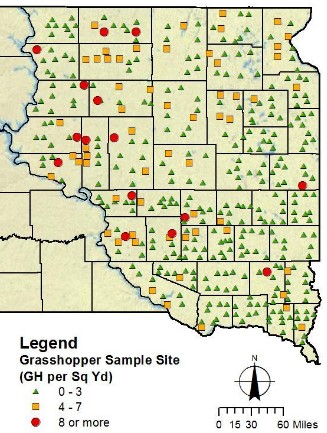By Adam Varenhorst
In South Dakota, there are several species of grasshoppers that can have a negative impact on rangeland health. The United States Department of Agriculture’s (USDA) Animal Plant Health Inspection Service (APHIS) conducts an annual survey to monitor grasshopper populations in Western South Dakota. In 2018, SDSU conducted a survey to monitor grasshopper populations in Eastern South Dakota. The focus of these surveys are nymph and adult grasshoppers. The survey from the previous year (i.e., 2018) can be used as a prediction tool for where grasshoppers may be an issue during the upcoming season.
Western South Dakota
In 2018, the grasshopper populations in Western South Dakota were relatively low; however, there were still a few isolated areas where the populations exceeded the threshold of 8 or more adult grasshoppers per square yard. The areas included Dewey, Fall River, Haakon, Harding, Lyman, Gregory, Mellette, Todd and Tripp counties (Figure 1). Using the Gaussian process regression in ArcGIS, we were able to take into account the weight of each data point to create a predictive map for 2019 grasshopper populations in Western South Dakota (Figure 2). Based on this method, the greatest risk areas for 2019 include Dewey, Gregory and Lyman counties.
Figure 1. Map of 2018 grasshopper abundance for Western South Dakota. Green triangles indicate grasshopper populations that were below threshold, orange squares indicate grasshopper populations that were approaching threshold, and red circles indicate grasshopper populations that exceeded threshold.
Figure 2. Predictive heat map based on 2018 grasshopper abundance for Western South Dakota. Green indicates low grasshopper populations, yellow-orange indicates grasshopper populations that were approaching threshold, and red indicates grasshopper populations that exceeded threshold.
Eastern South Dakota
In 2018, the grasshopper populations in Eastern South Dakota were relatively low for most counties. However, there were still a few areas where the populations exceeded the threshold of 8 or more adult grasshoppers per square yard. The areas included Aurora, Brookings, Brule, Buffalo, Faulk, Hand, Hughes, Hyde, McPherson, Potter, Sanborn, Sully, Turner and Walworth counties (Figure 3). Using the same Gaussian process regression in ArcGIS we were able to take into account the weight of each data point to create a predictive map for 2019 grasshopper populations in Eastern South Dakota (Figure 4). Based on this method, the greatest risk areas for 2019 include Edmunds, Faulk, Hand, Hyde, Hughes, Sully and Potter counties.

Figure 3. Map of 2018 grasshopper abundance for Eastern South Dakota. Green triangles indicate grasshopper populations that were below threshold, orange squares indicate grasshopper populations that were approaching threshold, and red circles indicate grasshopper populations that exceeded threshold.
Figure 4. Predictive heat map based on 2018 grasshopper abundance for Eastern South Dakota. Green indicates areas with low grasshopper populations, yellow-orange indicates areas where grasshopper populations were approaching threshold, and red areas indicates grasshopper populations that exceeded threshold.
Population Outlook
The 2018 spring may have played a major part in the reduced adult populations that were observed during the survey. Cool temperatures that were experienced throughout most of South Dakota resulted in grasshopper development being behind schedule. The April snowstorms may have had detrimental effects on early emerging grasshopper species as well. Many of the observed populations were still nymphs in late July when we would normally expect to see adult grasshoppers. Although development was behind schedule, the first 28°F frost for most of South Dakota didn’t occur until the first or second week of October (Figure 5). This would have given the grasshoppers plenty of time to reach maturity and lay eggs. Although there were some very cold days during the winter this year, it is unlikely that the freezing temperatures had much of an impact on the overwintering grasshopper eggs due to the heavy snow layer that would have provided insulation for eggs beneath the soil surface.
Although this article may provide some insight into where additional scouting efforts are needed for 2019, all crops and rangeland should be routinely monitored for grasshopper populations to prevent economic loss.
Figure 5. 2018 South Dakota first 28°F frost map.